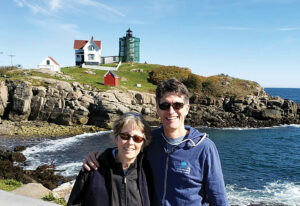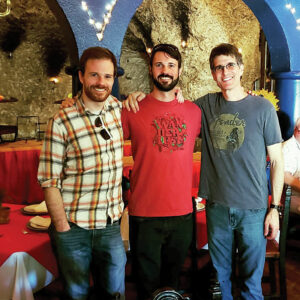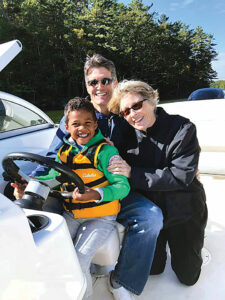By Dakota Antelman, Contributing Writer

HUDSON – Phil Knutel has three adopted children. Halfway across the country, Maggie Byrnes briefly helped families like Phil’s navigate the adoption process.
Roughly three years ago, a chance DNA test brought these two together with one truth–Byrnes is Knutel’s birth mother.
After having to give Knutel up for adoption herself, Byrnes delved into a life of social work. Knutel grew up and began raising children the same way his adoptive parents had raised him.
Now, a mother and her son have reconnected.
Growing up in Michigan
Byrnes lived in Kalamazoo, Michigan. But her strictly Catholic family was not pleased when she got pregnant part-way through college. So, Byrnes paused her pursuit of an English degree and headed off to a “home for unwed mothers” in Cleveland, Ohio.
“It was this real hush-hush kind of thing,” she said.
Living in that facility, Byrnes sent letters home weaving a fictional tale of world travels to keep her younger siblings from learning what was actually happening.
At one point, a family member told Byrnes she should simply marry the father of her child.
“He said no one else would want me,” Byrnes recalled.
For the trauma of that time, though, Byrnes eventually gave birth to Phil. She said she “sorrowfully” put him up for adoption and moved forward with a life now reshaped by her experience.
No longer was she studying English. Instead, as Byrnes went to grad school, she dove into a career in social work. One particularly kind nun back at the home in Cleveland had inspired her.
Byrnes got her Masters of Social Work, moved to Colorado and, at one point, helped screen families seeking to adopt children through the US government’s “Operation Babylift” in the final days of the Vietnam War.
Searching for each other
As he and his mother both grew up, Knutel settled into his own life, adopted from Cleveland by parents who happened to live only an hour from Kalamazoo.
His adoptive parents took care of him.
Due in part to strict and harsh words from a state trooper who warned a young Knutel not to look for his mother, though, it took until Knutel’s late teen years to consider reconnecting.
At that point, he engaged in an unknowing act of kinship with Byrnes.
“I remember sort of looking around for my mother, looking at people’s faces in a city of a million,” Knutel said.
Knutel knew he had been born in Cleveland. So, he started looking while living in the city for a year in college.
Byrnes, meanwhile, knew Knutel had been adopted in Kalamazoo and, therefore, did similar looking there.
Meeting thanks to modern technology

Not immediately connecting, Knutel and Byrnes continued on divergent but somehow similar paths.
Byrnes eventually got married and had two sons in Colorado.
Knutel got married as well, relocating to Hudson and adopting three sons.
As they aged, Byrnes and Knutel both eventually sought DNA testing through the company 23andMe in part to identify any propensity for genetic diseases.
Neither found anything medically alarming. Instead, they found each other.
“I was astounded because he looked so much like me,” Byrnes said. “…And we have so much in common.”
The two first connected by messaging within the 23andMe service. They then jumped to phone calls. Then they met in person.
“It was just a surreal experience,” Knutel said of that first meeting. “It was something I never really thought would happen.”
Experiencing a larger system
Knutel and Byrnes spent years wondering about each other. That, in some respects, is not unusual within parts of the adoption community.
For years, “closed adoptions” were the status quo across the US, NPR host Steve Inskeep wrote in a recent New York Times op-ed.
However, that caused problems even after modern adoption systems introduced reforms, Inskeep elaborated.
There is now a growing wave of writing, activism and legislation to further change the adoption system to make it easier for biological parents and their children to connect if all parties consent to such a relationship.
Discussing new questions

That decision to connect is personal, Inskeep notes.
For Knutel specifically, all this has posed unique questions — his youngest son started talking about wanting to meet his birth mom when he was just four years old.
“I don’t think I was really prepared for that,” he noted.
Knutel says he’s wary about setting up false expectations but has engaged in conversations about identity, family and ancestry, conversations he’s uniquely qualified to handle.
At the end of it all, as he navigated a life quietly underpinned by his story of adoption, Knutel pulls a prominent lesson from his new relationship with his mother.
“Maybe you do [meet your mother],” he tells his sons. “Maybe you don’t. If you do, that’s fine. If you don’t, that’s fine. A family is what you make it, based on love, not on biology.”
Photos/submitted












